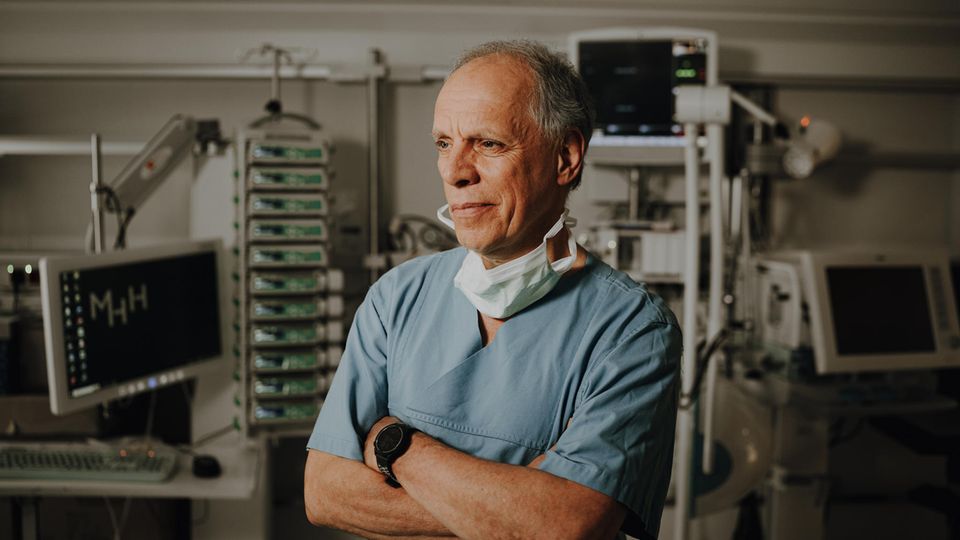North Rhine-Westphalia’s hospitals are feeling the pressure to reform. A new online tool shows where certain procedures will no longer be offered in the future and which clinics will perform them instead.
A red dot on the map – a symbol of defeat: the Marienhospital in Oelde (Münsterland) had applied to the state of North Rhine-Westphalia for 600 births per year – but none were approved. The Rheine hospital on the border with Lower Saxony, on the other hand, wanted 2,400 births – and was allocated 2,551. Its dot is therefore blue. Green stands for hospitals that were allocated exactly what they wanted. The most common color on the map, which the Science Media Center in Cologne has made available to everyone today, is yellow.
And that means: “partially approved”. The relevant hospitals should therefore continue to carry out the respective medical measures and interventions, but in very limited numbers. From general surgery to spinal surgery, anyone interested can now find out about the future of the medical fields in the clinics in their region in a way that has never been seen before.
This control of the services provided by the individual clinics is an essential pillar of the hospital reform in the largest federal state, which also has by far the most hospital beds. Its architect, Health Minister Karl-Josef Laumann (CDU) and his team of experts, have divided the medical services into so-called service groups. They want to manage their capacities more specifically and achieve greater efficiency and quality in the results. The project of the century is a pioneering feat, and the nationwide restructuring of the hospital landscape will be based on it – and will have to be measured against it.
Hospitals: The end of the general store?
It has been clear for years that not everyone can do everything, and not everyone should do everything. The false incentives that politicians themselves have created through the so-called flat-rate fees have long been known – and which make it attractive, for example, to have hip replacements, but rather discouraging to provide comprehensive medical care for children. The service groups and their allocation by the state therefore regulate which treatments are offered locally and in what quantities. This is intended to promote specialization: clinics must meet a series of minimum criteria in order to be able to compete with potentially superior hospitals.
The principle has already proven itself in metropolitan regions such as the city of Essen, which has a wealth of good clinics: obstetrics has been successfully concentrated there, which has strengthened it, ensured sufficient capacity for training and is now also widely accepted. In important sub-areas, such as stroke care or general internal medicine, it is becoming apparent that the state’s planning is trying to ensure comprehensive care in a balanced way. Because while red dots are sometimes concentrated where there is an oversupply of competing clinics, decision-makers are counteracting this in other places, as the Science Media Center concludes from initial sample evaluations with its new tool – where there is a shortage, “the number of cases must be increased to ensure care for the population, for example at the ‘Evangelisches Krankenhaus Mettmann’ and ‘Fachklinik 360°’ (Ratingen) clinic locations. The background in this case is the closure of the St. Marien Hospital in Ratingen, which means that surrounding clinics have to take on more cases.”

“It’s always about survival” – why an intensive care doctor can no longer care for all children
10:21 min
Hospital planning is a state matter
It has been apparent for years that North Rhine-Westphalia would become a pioneer in the change in hospital design. Minister Laumann has openly made the reform project his own. The veteran of Christian Democratic social policy is acting with robust self-confidence. Laumann recently said that his reorganization could “serve as a blueprint for hospital reform at the federal level and the plans of the other federal states.”
According to a widespread misconception, “the Minister of Health”, generally understood as “Karl Lauterbach”, directs “the health care system”. In reality, however, things work differently. Planning the hospital landscape is a matter for the states, as is the maintenance of the buildings, for example in terms of construction – a duty that they sometimes fulfill rather sloppily.
The federal government, on the other hand, exerts the greatest influence in hospitals through its sovereignty over statutory health insurance – it has its hand on the money tap for specific treatment cases, and it was ultimately the federal government that made hips and heart catheters so excessively valuable that German patients are provided with them to a far greater extent than would be healthy for them. Laumann, who is distinguished by a talent that is also viewed with respect by his critics, has skilfully managed to listen to and involve each of the enormous number of associations, umbrella organizations, professional societies, chambers, unions and sponsors, whether church, non-profit or municipal. Lauterbach, on the other hand, who is less rooted in the people, prefers to listen to science, a field in which he is extremely well versed. What does this mean for patients in North Rhine-Westphalia?
Clinical services limited regionally
In the specific example of obstetrics in Oelde, it is said that there should be a winner nearby – and that is the case. The St. Franziskus Hospital in Ahlen, less than 25 kilometers away, is said to be able to handle more births than requested. However, there are also several yellow dots in the area, which means an overall decline in the range of services on offer. In general, this does not mean that there is a risk of a shortage of care – for a long time, North Rhine-Westphalia had around four times as many hospitals as the neighboring Netherlands, which has a similarly large population.
One thing is certain: In the long term, long journeys for planned interventions will become the norm for many people – the small-town hospital that implants a manageable number of hips is not what health policy is aiming for in the future. The responsible patient, and this is seen with some justification, would be better off travelling to the region’s quality leader. Laumann also wants to specifically combat the “ruinous competition for staff and resources” between hospitals.
However, it is already becoming apparent that the near future will provide material for serious controversy, as the Science Media Center shows using the example of stroke care: “In the Hochsauerland district, for example, two clinics that applied for the LG ‘Stroke Unit’ did not receive approval from the district government for the LG ‘Stroke Unit’: the St. Vinzenz Hospital and the DGD Stadtklinik Hemer. According to the district government, the two clinics either did not meet the minimum criteria or had no experience in the special care of stroke patients. The previous provider, the Karolinen Hospital Hüsten (844 cases), is considered sufficient for the care.”
Only practice can show whether the government is right in this regard.
Source: Stern
I’m Caroline, a journalist and author for 24 Hours Worlds. I specialize in health-related news and stories, bringing real-world impact to readers across the globe. With my experience in journalism and writing in both print and online formats, I strive to provide reliable information that resonates with audiences from all walks of life.




